Abstract
Ostrich raising around the world have some key factors and farming profit depend largely on information and ability of farmers to rear these animals. Non fertilized eggs from ostriches are discharged in the reproduction season. Staphylococcus aureus and Escherichia coli are microorganisms involved in animal and human diseases. In order to optimize the use of sub products of ostrich raising, non fertilized eggs of four selected birds were utilized for development of polyclonal IgY antibodies. The birds were immunized (200ug/animal) with purified recombinant staphylococcal enterotoxin C (recSEC) and synthetic recRAP, both derived from S. aureus, and recBFPA and recEspB involved in E. coli pathogenicity, diluted in FCA injected in the braquial muscle. Two subsequent immunization steps with 21 days intervals were repeated in 0,85% saline in FIA. Blood and eggs samples were collected before and after immunization steps. Egg yolk immunoglobulins were purified by precipitation with 19% sodium sulfate and 20% ammonium sulphate methodologies. Purified IgY 50μL aliquots were incubated in 850μL BHI broth containing 50μL inoculums of five strains of S. aureus and five strains of E.coli during four hours at 37°C. Growth inhibition was evaluated followed by photometry reading (DO550nm). Egg yolk IgY preparation from hiperimmunized birds contained antibodies that inhibited significantly (p<0,05) growth of strains tested. Potential use of ostrich IgY polyclonal antibodies as a diagnostic and therapeutic tool is proposed for diseased animals.
Keywords: Ostrich IgY antibodies, inhibition, recombinant proteins, E. coli, S. aureus
INTRODUCTION
Ostrich (Struthio camelus) raising need experience and information from farmers and successful ostrich farming is largely dependent on the ability of farmers to rear sufficient numbers of viable and healthy chicks. However, high mortality of ostrich chicks particularly during the first months of life is a problem (8). Mortality can be reduced by correct housing, feeding and health management of chicks at hatch and during the brooding period, and some microorganisms were isolated and involved in ostrich chicks mortality (19, 28). Among microorganisms isolated from ostriches E. coli and staphylococci may colonize and eventually cause diseases in the host (1, 17, 19). Staphylococcus aureus can pose as an infectious agent due to virulence factors secreted by some clone and multidrug resistance is one of the main features (20). The bacteria can also secrete toxins with superantigenic properties (10), with enterotoxins secretion commanded by the agr loci after activation of RNA III Activating Protein -RAP (7). Anti-RAP antibodies inhibited in vivo infection caused by S. aureus in mouse (6, 11) and in vitro growth and secretion of enterotoxins by different strains of S. aureus were inhibited by specific antibodies developed against synthetic peptide RIP involved in agr activation (27, 28). S. aureus is also considered one of the main agents causing mastitis in cattle (1, 29). Diseases caused by Escherichia coli also pose as important losses for human and animals. Pathogenic strains enterotoxigenic E. coli (ETEC), enteropathogenic E. coli (EPEC), enteroinvasive E. coli (EIEC), enterohemorragic E. coli (EHEC), enteroagregative E. coli (EAEC) and extraintestinal patogenic E. coli (EXPEC) are among the causes of diarrhea in human and animal leading to economic loss for farmers, including birds and mammals (18). Antibodies developed against several microorganisms in chickens, also known as IgY, has been proved to be an alternative for immunological diagnostic tool, as well as suggested as immunotherapic purposes (4, 12, 13, 15, 17, 21, 31). The aim of this work was to demonstrate for the first time the inhibitory activity of polyclonal antibodies developed in ostriches against recombinant proteins recRAP and recSEC from S. aureus and recBFPA and recEspB from E.coli, towards clinical and standard strains of S. aureus and E. coli in vitro.
MATERIALS AND METHODS
Recombinant proteins/antigens
Four ostriches in breeding season were immunized three times with recombinant proteins (200μg/animal) at intervals of 21 days in the brachial muscle of birds. The selected recombinant proteins were recSEC and recRAP derived from S. aureus and recEspB and recBFPA from E. coli, previously used by others (2, 26). From each female blood and non-fertilized eggs were collected before and after each immunization step, in order to obtain negative controls.
Immunization scheme
Four ostriches were primed on day 0 by injecting 200μg of antigens previously incorporated in complete Freund's adjuvant into the wing muscle. The birds were subsequently injected two times with the antigens in physiological saline at 21 days intervals. Blood samples and eggs were collected immediately before and during the course of immunization. The blood was allowed to clot at room temperature and the centrifuged sera stored at -20° C. The collected eggs were stored at 4° C before being used to prepare IgY.
Purification of chicken IgY
The method used by others (3, 27) was carried out by diluting one part of egg yolk in nine equal volumes of distilled water, pH 5.0 to 6.0. The mixture was allowed to stand overnight at 4°C. Non-immunoglobulin proteins precipitated after centrifugation at 10,000 xg for 30 minutes at 4°C were discarded, and the supernatant was collected. Following the material rich in IgY antibodies was submitted to second precipitation step by two methodologies. After the mixtures were allowed to stand at room temperature, part was precipitated with 19% sodium sulphate solution (w/v) (Merck, Germany) and other part was precipitated with 20% ammonium sulphate solution (w/v) (Merck, Germany) and the precipitates containing IgY were dissolved in isotonic PBS, pH 7.5, and dialyzed at 4°C against the same buffer for three days. All samples were submitted to sterilization step by membrane filtration 0,22μm, and stocked at -20°C.
Polyclonal antibodies titration: All animals had the serum collected and tested for anti-recombinant proteins activities after a 10 days immunization period and their eggs.
Immunochemical methods: ELISA was performed as described (3, 27) using recombinant proteins, serum or yolk IgY antibodies obtained from the immunized ostriches, and goat anti-hen IgY (Sigma, USA) as reagents. Serum samples from previous non-immunized ostriches were used as negative controls.
Protein concentration assays
To determine protein concentration biscinchoninic acid assay (Sigma, USA) was performed according to instructions from mannufacturer. Detection of protein levels were read in a spectrophotometer at 570 nm (Dynatech MR 5000).
Bacterial inoculums
Stocks of S. aureus from bacterial collection of Laboratory of Animal Health, FRI 361, a SEC producer strain, S. aureus LSA88 a bovine SEC/SED producer strain, S. aureus ATCC 25923, and two clinical S. aureus strains isolated from ostriches Saost1 e Saost2 were cultured in Brain Hearth Infusion broth (BHI, Acumedia, USA) overnight at 37°C. E.coli strains included EPEC (E2348/69), EAEC (O42), ETEC (H10407), EIEC (EDL1284), EHEC (EDL931), kindly furnished by Dra. Katia R.S. Aranda, from UNESP/Brazil) (5), cultured in BHI overnight at 37°C, were used in vitro on growth triplicate inhibition experiments.
IgY antibodies inhibitory activity
From each stock of S. aureus and E. coli were prepared the inoculums in 0,85% saline solution, rendering approximately 1,5x108 cells/mL, corresponding to photometric reading 0,5 McFarland concentration (DO550nm) (Densimat, Biomerieux, France) of each bacteria. Bacterial samples were cultured in BHI medium (Acumedia, USA) at 37°C, in a four hours incubation period in the presence of 50 μL of each IgY solution (5,0 mg/mL) under a constant shaking and growth followed by photometric reading (DO550nm). After reading, samples of treated cells were inoculated in PCA and McConkey agar medium, for S. aureus and E. coli, respectively, to evaluate cells viability. Statistical analyses used Tukey test (p<0,05).
RESULTS AND DISCUSSION
These results using bacteria strains from animal and human origin may represent an advance in the IgY techonology. Antibodies were developed in ostriches immunized with recombinant recSEC and recRAP proteins derived from S. aureus, and recBFPA and recEspB derived from E. coli and were purified from their egg yolk, aiming the development of alternative tools for diagnostic and treatment of infections caused by these pathogens. Results obtained by both sodium sulphate precipitation (SSP) and ammonium sulphate precipitation (ASP) methods, showed no significative differences by comparing the two preparations. Conversely, the results showed difference (p<0,05) among specific IgY treated strains and non treated controls (Figure 1 and 10). IgY antibodies developed in chickens, using antigens from S. aureus were tested by several authors. Toxigenic S. aureus strains had their growth abrogated in vitro by native antigens of S. aureus (9, 24, 32). Others described antibodies from serum against native SEC (23) and recombinant SEC (26), but this is the first work to describe development of IgY in ostriches immunized with SEC recombinant protein, and tested against growth of S. aureus strains from different origin. Sugita-Konishi et al. (24) demonstrated the growth inhibition activity of IgY on SEA producer S. aureus strains. The study of Uhl et al. (26) showed that policlonal IgY from chicken not just recognized SEC-producer S. aureus strains, but also inhibited cell growth from different origins. Guimarães et al. (9) have suggested that IgY activity could be a result of interaction of antibodies with components present in bacterial surface, albeit the target molecule has not yet been defined. Sunwoo et al. (25) confirmed interference of growth, as result of interaction of IgY antibodies from hens and surface components of E. coli cells by electronic microscopy. Figures 2 to 9 demonstrated the inhibition of cell growth of all staphylococcal cells used. The results of growth inhibition of E. coli from different sources were also observed by others by using IgY from chicken in vivo and in vitro assays (4, 33) and their therapeutic potential was suggested. Effects of IgY antibodies from chicken against E.coli strains conferring protection against gastrointestinal infections in different species as a food additive component (14), for treatment of diarrheic calves (18) and piglets (16, 22) were demonstrated. Our results showed in figure 10 the inhibition (p<0,05) of E.coli strains by comparing media of treatments with IgY before and IgY after treatment by S.A. and S.S. methods, respectively. The comparison between the two extraction methods there was no difference between the inhibition media. When the treated strains were compared among themselves it was observed that some strains presented higher difference between the inhibition media. Figures 11 to 18 demonstrated the inhibition of cell growth of all E. coli cells used. Conversely, when difference between the media was compared using control and treated cells a significant difference was observed in all assays. Here the abrogation of cell growth by IgY antibodies from ostriches was demonstrated but further studies are needed to confirm the possible interaction with S. aureus and E. coli surface components. The actual literature of IgY technology lacks information of polyclonal IgY from ostriches that presents activity on growth inhibition of S. aureus and E. coli. The results presented clearly show an appropriate information and plausible application of IgY antibodies from ostriches as a tool for immunodiagnostic and therapy caused by these pathogenic agents.
Figure 1.

showing growth inhibition assay after 4 hours incubation with IgY antibodies anti SECrec and RAPrec extracted from yolk of ostriches on S aureus strains extracted by A.S or S.S. methods. Media differences among DO550nm pre and post treatment.
Figure 10.

Showing growth inhibition assay after 4 hours incubation with IgY antibodies anti EspBrec and BFPArec extracted from yolk of ostriches on E. coli strains extracted by A.S or S.S. methods. Media differences among DO550nm pre and post treatment.
Figures 2 and 3.
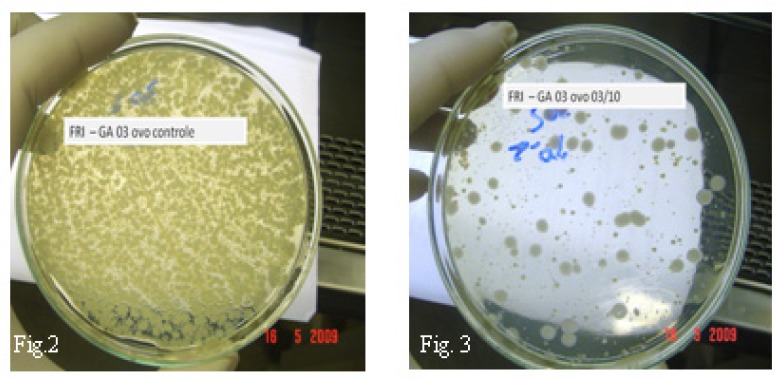
Showing growth inhibition activity assays of anti RAPrec IgY antibodies extracted from yolk of ostriches on S. aureus (FRI 361) extracted by S.S. method from yolk of ostrich, pre and e post treatment.
Figures 8 and 9.
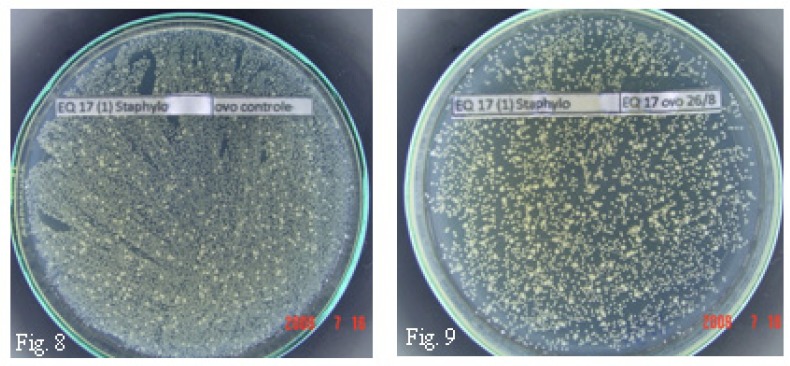
Growth inhibition activity assays of anti SECrec IgY antibodies extracted from yolk of ostriches on S. aureus (Saost1) extracted by A. S. method from yolk of ostrich, pre and post treatment. On left (6 and 8) negative controls showing confluent growth of cells and on right (7 and 9) isolated colonies after treatments.
Figures 11 and 12.
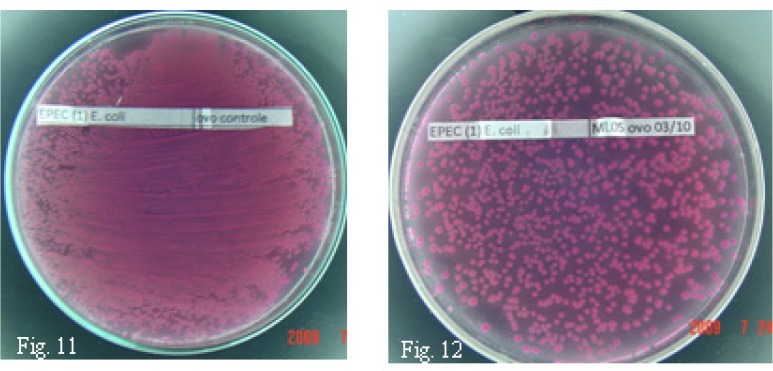
Showing growth inhibition activity assays of anti BFPArec IgY antibodies extracted from yolk of ostriches on E. coli (EPEC) extracted by S.S. method from yolk of ostrich, pre and e post treatment.
Figures 17 and 18.
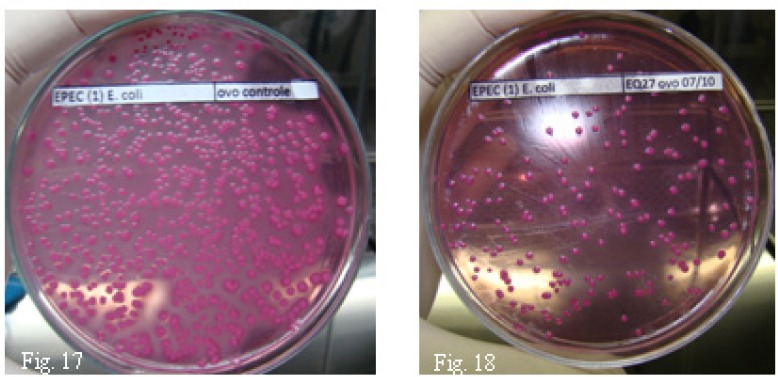
Growth inhibition activity assays of anti EspBrec IgY antibodies extracted from yolk of ostriches on E. coli (EPEC) extracted by A.S. method from yolk of ostrich, pre and post treatment. On left (15 and 17) negative controls showing confluent growth of cells and on right (16 and 18) isolated colonies after treatments.
Figures 4 and 5.
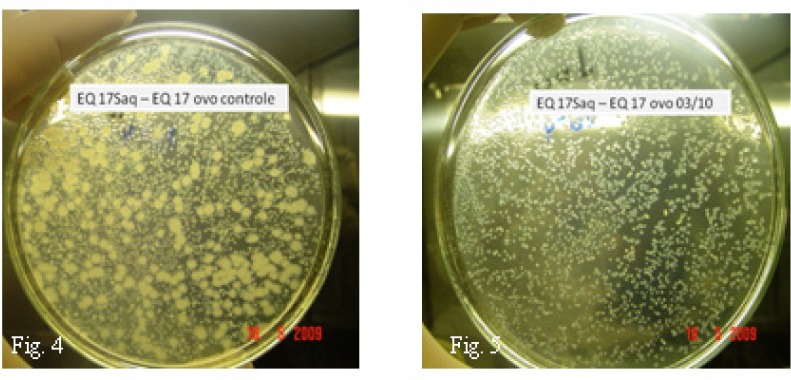
Growth inhibition activity assays of anti SECrec IgY antibodies extracted from yolk of ostriches on S. aureus (Saost1) extracted by S.S. method from yolk of ostrich, pre and post treatment. On left (2 and 4) negative controls showing confluent growth of cells and on right (3 and 5) isolated colonies after treatments.
Figures 6 and 7.
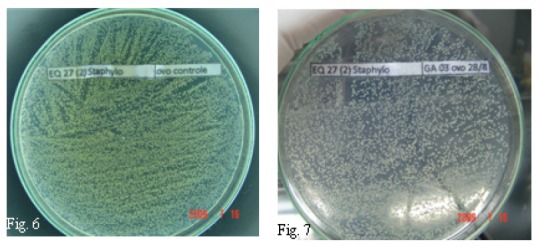
Showing growth inhibition activity assays of anti RAPrec antibodies extracted from yolk of ostriches on S. aureus (Saost2) extracted by A.S. method from yolk of ostrich, pre and e post treatment.
Figures 13 and 14.
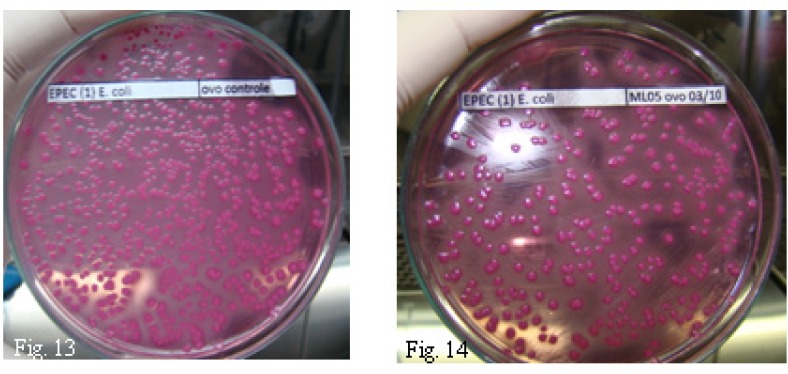
Growth inhibition activity assays of anti EspBrec IgY antibodies extracted from yolk of ostriches on E. coli (EPEC) extracted by S.S. method from yolk of ostrich, pre and post treatment. On left (11 and 13) negative controls showing confluent growth of cells and on right (12 and 14) isolated colonies after treatments.
Figures 15 and 16.
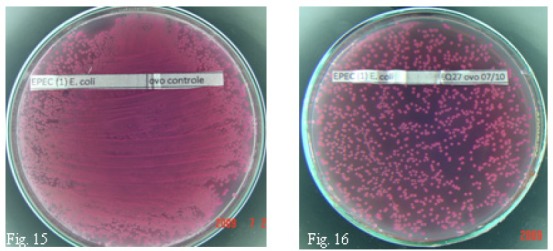
Showing growth inhibition activity assays of anti BFPArec IgY antibodies extracted from yolk of ostriches on E. coli (EPEC) extracted by A.S. method from yolk of ostrich, pre and e post treatment.
Acknowledgments
We thank to financial support to O.V.Motta by FAPERJ Editais Jovens Cientistas do Nosso Estado; Desenvolvimento Técnico Científico Regional; Grupos Emergentes and to the breeder Dr. Marconi Luna for animals and facilities availability to realize this work.
REFERENCES
- 1.Aires-de-Souza M., Parente C.E.S.R., Vieira-da-Motta O., Bonna I.C.F., Silva D.A., Lencastre H. Characterization of Staphylococcus aureus isolated from buffalo, bovine, ovine, and milk samples from Rio de Janeiro State, Brazil. Appl. Environ. Microbiol. 2007;73(12):3845–3849. doi: 10.1128/AEM.00019-07. [DOI] [PMC free article] [PubMed] [Google Scholar]
- 2.Almeida C.M.C., Quintana-Flores V.M., Medina-Acosta E., Schriefer A., Barral-Netto D.S.W. Egg Yolk anti-BfpA antibodies as a tool for recognizing and idenfifying enteropathogenic Eschirichia coli. Scand. J. Immun. 2003;57:573–582. doi: 10.1046/j.1365-3083.2003.01243.x. [DOI] [PubMed] [Google Scholar]
- 3.Almeida C.M.K., Kanashiro M.M., Rangel Filho F.B., Matta M.R.F., Kipnis T.L., Silva W.D. Development of snake antivenom antibodies in chickens and their purification from yolk. Vet. Rec. 1998;143:579–584. doi: 10.1136/vr.143.21.579. [DOI] [PubMed] [Google Scholar]
- 4.Amaral J.A., Franco M.T., Quintanilla L.Z., Carbonare S.B. In vitro reactivity and growth inhibition of EPEC serotype 0111 and STEC serotypes 0111 and O157 by homologous and heterologous chicken egg yolk antibody. Vet. Res. Commun. 2008;32:281–290. doi: 10.1007/s11259-007-9029-3. [DOI] [PubMed] [Google Scholar]
- 5.Aranda K.R.S., Fabbricotti S.H., Fagundes-Neto U., Scaletsky I.C.A. Single multiplex assay to identify simultaneously enteropathogenic, enteroaggregative, enterotoxigenic, enteroinvasive and Shiga toxin-producing Escherichia coli strains in Brazilian children. FEMS Microbiol Lett. 2007;267:145–150. doi: 10.1111/j.1574-6968.2006.00580.x. [DOI] [PubMed] [Google Scholar]
- 6.Balaban N., Goldkorn T., Nhan R.T., Dang L.B., Scott S., Rigley R.M., Rasooly A., Wright S.C., Larrick J.W., Rasooly R., Carlson J.R. Autoinducer of virulence as a target for vaccine and therapy against Staphylococcus aureus. Science. 1998;280:438–440. doi: 10.1126/science.280.5362.438. [DOI] [PubMed] [Google Scholar]
- 7.Balaban N., Novick R.P. Autocrine regulation of toxin synthesis by Staphylococcus aureus. Proc. Nat. Acad. Sci. 1995;92:1619–1623. doi: 10.1073/pnas.92.5.1619. [DOI] [PMC free article] [PubMed] [Google Scholar]
- 8.Glatz P., Miao Z. Reducing Mortality Rates in Ostrich Chicks. Rural Industries Research and Development Corporation. 2008;08(187):1–27. [Google Scholar]
- 9.Guimarães M.C. C., Amaral L.G., Rangel L.B.A., Silva I.V., Matta C.G., Matta M.F. Growth inibition of Staphylococcus aureus by chicken egg yolk antibodies. Arch. Immunol. Ther. Exp. 2009;57:377–382. doi: 10.1007/s00005-009-0041-x. [DOI] [PubMed] [Google Scholar]
- 10.Jarraud S., Peyrat M. A., Lim A., Tristan A., Bes M., Mougel C., Etienne J., Vadenesch F., Bonneville M., Lina G. Egc, a high prevalent operon of enterotoxin gene, forms a putative nursery of superantigens in Staphylococcus aureus. J. Immun. 2001;166:669–677. doi: 10.4049/jimmunol.166.1.669. [DOI] [PubMed] [Google Scholar]
- 11.Kiran M.D., Adikesavan N.V., Cirioni O., Giacometti A., Silvestri C., Scalise G., Ghiselli R., Saba V., Orlando F., Shoham M., Balaban N. Discovery of a quorum-sensing inhibitor of drug-resistant staphylococcal infections by structure-based virtual screening. Mol. Pharmacol. 2008;73:1578–1586. doi: 10.1124/mol.107.044164. [DOI] [PubMed] [Google Scholar]
- 12.Kolberg H., Carlander D., Olesen H., Wejaker P.E., Johannesson M., Larsson A. Oral administration of specific yolk antibodies (IgY) may prevent Pseudomonas aeruginosa infections in patients with cystic fibrosis: A phase I feasibility study. Pediatr. Pulmon. 2003;35:433–440. doi: 10.1002/ppul.10290. [DOI] [PubMed] [Google Scholar]
- 13.Lee E. N., Sunwoo H. H., Menninen K., Sim J. S. In vitro studies of chicken egg yolk antibody (IgY) against Salmonella enteritidis and Salmonella typhimurium. Poult. Sci. 2002;81(5):632–41. doi: 10.1093/ps/81.5.632. [DOI] [PubMed] [Google Scholar]
- 14.Mahdavi H.R., Rahmani H.R., Nili N., Samie A.H., Soleimanian-Zad S. Chichen egg yolk antibody (IgY) powder against Escherichia coli 078:K80. J. An. Vet. Adv. 2010;9(2):366–373. [Google Scholar]
- 15.Malik M.W., Ayub N., Qureshi I.Z. Passive immunization using purified IgYs against infectious bursal disease of chickens in Pakistan. J.Vet.Sci. 2006;7(1):43–46. doi: 10.4142/jvs.2006.7.1.43. [DOI] [PMC free article] [PubMed] [Google Scholar]
- 16.Marquardt R. R., Jin L. Z., Kim J., Fang L., Frohlich A. A., Baidoo S. K. Passive protective effect of egg-yolk antibodies against enterotoxigenic Escherichia coli K88+ infection in neonatal and early-weaned piglets FEMS. Imunol. Med. Microbiol. 1999;23:283–288. doi: 10.1111/j.1574-695X.1999.tb01249.x. [DOI] [PubMed] [Google Scholar]
- 17.Melville P.A., Cogliati B., Mangiaterra M.B.B.C.D., Peres M.R., Moura S.C.A., Matsuda L., Kim A., Benites N.R. Determinação da microbiota presente na cloaca e orofaringe de avestruz (Struthio camelus) clinicamente sadios. Ciência Rural. 2004;34(6):1871–1876. [Google Scholar]
- 18.Mine Y., Kovacs-Nolan J. Chicken egg yolk antibodies as therapeutics in enteroinfectious disease: a review. J. Med. Food. 2002;5:159–69. doi: 10.1089/10966200260398198. [DOI] [PubMed] [Google Scholar]
- 19.Nardi A.R., Salvadori M.R., Coswig L.T., Gatti M.S., Leite D.S., Valadares G.F., Neto M.G., Shockenn-Iturrino R.P., Blanco J.E., Yano T. Type 2 heat-labile enterotoxin (LT-II): producing Escherichia coli isolated from ostriches with diarrhea. Vet. Microbiol. 2005;105(3-4):245–249. doi: 10.1016/j.vetmic.2004.11.005. [DOI] [PubMed] [Google Scholar]
- 20.Peng H.L., Novick R.P., Kreiswirth B., Kornblum J., Sclievert P. Cloning, characterization, and sequencing of na accessory gene regulator (agr) in Staphylococcus aureus. J. Bacteriol. 1988;170:4365–4372. doi: 10.1128/jb.170.9.4365-4372.1988. [DOI] [PMC free article] [PubMed] [Google Scholar]
- 21.Rangel M.F.N., Lemos L.S., Almeida C.M.C., Sales L.G., Vieira-da-Motta O. Development of IgY antibodies in chickens and IgG in rabbits immunized against proteins of Pythium insidiosum isolated from horses in the state of Rio de Janeiro. Pesq. Vet. Bras. 2010;30(1):87–93. [Google Scholar]
- 22.Ribeiro A.M.L., Pinheiro C.C., Silva I.M. Uso de gema de ovo de galinhas hiperimunizadas para vacinação de suínos. Acta Sci Vet. 2007;35:131–137. [Google Scholar]
- 23.Robbins R., Gould S., Berdoll M. Detecting the enterotoxigenicity of Staphylococcus aureus strains. Appl. Microbiol. 1974;28:946–950. doi: 10.1128/am.28.6.946-950.1974. [DOI] [PMC free article] [PubMed] [Google Scholar]
- 24.Sugita-Konishi Y., Shibata K., Yun S.S., Hara-Kudo Y., Yamaguchi K., Kumagai S. Immune functions of immunoglobulin Y isolated from egg yolk of hens immunized with various infectious bacteria. Biosci. Biotech. Biochem. 1996;60(5):886–888. doi: 10.1271/bbb.60.886. [DOI] [PubMed] [Google Scholar]
- 25.Sunwoo H.H., Lee E.N., Menninen K., Suresch M.R., Sim J.S. Growht inhibitory effect of chicken egg yolk antibody (IgY) on Escherichia coli O157:H7. J. Food Sci. 2002;67(4):1486–1494. [Google Scholar]
- 26.Uhl M.V.C., Bottecchia R.J., Azevedo-Silva J., Antonio D.L., Vieira-da-Motta O., Mittmann J., Damasceno Ribeiro P., Souza Campos Fernandes R.C., Távora N., Medina-Acosta E. Suitability of a recombinant Staphylococcus aureus enterotoxin C bovine variant for immunodiagnostics and therapeutic vaccine development. Vaccine. 2004;22:4191–4202. doi: 10.1016/j.vaccine.2004.05.004. [DOI] [PubMed] [Google Scholar]
- 27.Vieira-da-Motta O., Medina-Acosta E., Almeida C.M.C., Kipnis T.L., Dias da Silva W. Development of anti-Staphylococcus aureus enterotoxins antibodies in chickens and their purification from yolk. Scand. J. Immunol. 2001;(sB 54):117. supplement 1, 117. [Google Scholar]
- 28.Vieira-da-Motta O., Damasceno P.R., Dias da Silva W., Medina-Acosta E. RNAIII Inhibiting Peptide (RIP) inhibits agr-regulated toxin production. Peptides. 2001;22:1621–1627. doi: 10.1016/s0196-9781(01)00497-1. [DOI] [PubMed] [Google Scholar]
- 29.Vieira-da-Motta O., Folly M.M., Sakyiama C.C.H. Detection of different Staphylococcus aureus strains in bovine milk from subclinical mastitis, using PCR and routine techniques. Braz. J. Microbiol. 2001;32:27–31. [Google Scholar]
- 30.Vieira-da-Motta O., Silveira L.S., Teixeira G.N., Cardinot C. B., Lemos L.S., Silva R.S.T., Branco A.T. Diagnóstico microbiológico e histopatológico de mortalidade em avestruzes (Struthio camelus) Arq. Bras. Med. Vet. Zoot. 2008;60:1014–1016. [Google Scholar]
- 31.Yu-Hong Z, Li-Ji J., Xiao-Yu L., Jie G, Zhi L., Bao-Jing Z., Rui F., Yong-Ping X. Efficacy of specific egg yolk immunoglobulin (IgY) to bovine mastitis caused by Staphylococcus aureus. Vet. Microbiol. 2009;133:317–322. doi: 10.1016/j.vetmic.2008.07.016. [DOI] [PubMed] [Google Scholar]
- 32.Zhen Y.H., Jin L.J., Guo J., Li X.Y., Li Z., Fang R., Xu Y.P. Characterization of specific egg yolk immunoglobulin (IgY) against mastitis-causing Staphylococcus aureus. J. Appl. Microbiol. 2008;105:1529–1535. doi: 10.1111/j.1365-2672.2008.03920.x. [DOI] [PubMed] [Google Scholar]
- 33.Zhen Y.H., Jin L.J., Guo J., Li X., Lu Y., Chen J., Xu Y. Caracterization of specific egg yolk immunoglobulin (IgY) against mastitis-causing Escherichia coli. Vet. Microbiol. 2008;130:126–133. doi: 10.1016/j.vetmic.2007.12.014. [DOI] [PubMed] [Google Scholar]


